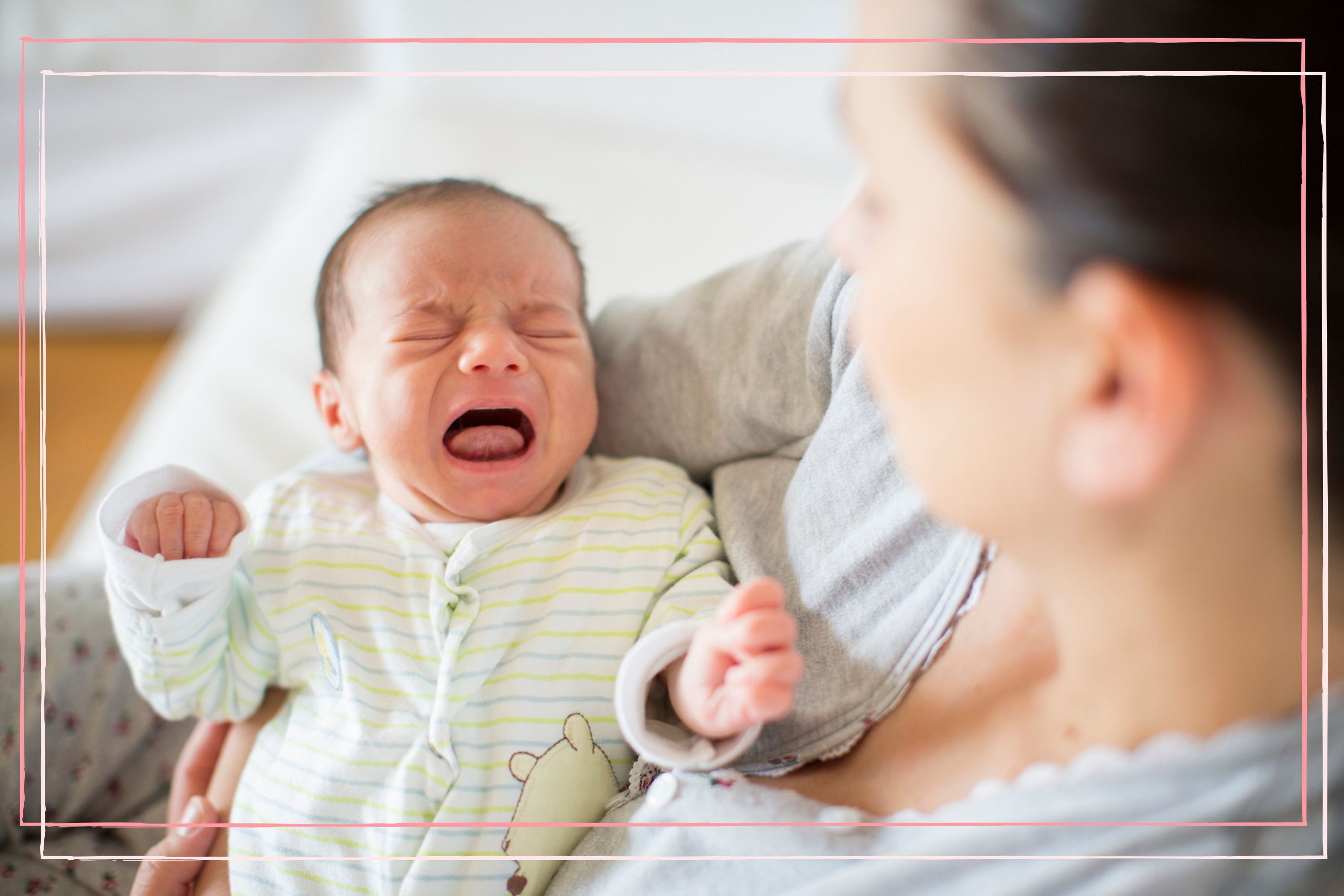What is colic in newborns, how long does it last and how do you settle a baby with colic?
An awarded paediatric doctor and experienced midwife answer your questions about colic in newborns and share their expert advice


Colic in newborns is a common problem that will pass with time, but it can be stressful and upsetting for parents.
All babies cry, but if your baby cries a lot and there's no obvious cause and they are otherwise healthy, they might have colic.
Here, awarded GP and paediatric doctor Stuart Sanders and experienced, practising Midwifery Sister Pip Davies answer your most common questions about colic and share advice on how to help soothe your colicky baby.
Although colic is common in babies and usually nothing to worry about, parents should always follow the NHS advice about getting to know their newborn. If you are worried about your baby or you notice a change in their behaviour - such as not feeding well, being very sleepy, or very irritable - contact your GP immediately.
The information in this article is for general purposes only and does not take the place of medical advice. It is essential to be guided by your GP and take note of official NHS advice. You should immediately seek medical attention if symptoms worsen or you are concerned about your child.

Dr Sanders is a registered medical practitioner who graduated at the University of Leeds where he was awarded the Medical School prize in paediatrics. He subsequently gained diplomas in child health and obstetrics and has been presented with the Huntarian Society and The Independent Doctors Federation medals. Dr Sanders has considerable experience in family medicine and has been awarded the Fellowship of the Royal College of General Practitioners by Assessment.

Pip is an experienced, practicing Midwifery Sister in the UK who is currently working as a Delivery Suite Sister and as a Specialist Pelvic Health Midwife. Pip has a first class BSc in Midwifery and a MSc in Professional Development. As well as having a KGH Hypnobirthing Diploma, she is Pre and Postnatal Exercise qualified and a certified Mummy MOT practitioner. Pip is also the founder of Midwife Pip Podcast, a Hypnobirthing and Antenatal Educator, co-author of published research and a mum.
What is colic in newborns?
"Colic is when an otherwise healthy baby cries more often than is normal and for prolonged periods of time, often at the same time of day," explains Midwife Pip. “There is no certain cause for colic but it is thought to be digestive discomfort or sensitivity to digesting milk whilst they are so young which leads to a cramping feeling in a baby’s stomach and hence the excessive crying."
Pip adds that, "although [colic is] possible to happen later [in a child’s life] and even in adults, it is most common in newborn babies."
Parenting advice, hot topics, best buys and family finance tips delivered straight to your inbox.
Dr Sanders explains that, "Colic [in adults] is abdominal pain caused by spasm or blockage in a tubular organ such as the intestine or ureter. Infantile colic is a different condition affecting newborn babies, a condition for which there is no known cause. It may result from the effect of milk on an immature digestive system. There is no apparent reason and it usually occurs in the evening. Infantile colic affects both breast and bottle fed babies."
What are signs of colic in a baby and what is the 3 3 3 rule?
The main sign of colic in a baby is how often they cry, and as all babies cry, the 3 3 3 rule is often used to help diagnose the condition. "This means a baby who cries for more than 3 hours a day, for more than 3 days and for longer than 3 weeks," says Pip.
Dr Sanders explains that this "diagnostic indicator" can be used to measure if your otherwise healthy baby is crying more than might be considered usual, so if, "the baby cries for three hours a day, for three times a week, lasting for three weeks or more," then that might be a sign they have colic.
Pip explains that there are some other signs that a baby might be suffering colic in addition to the frequency of their crying, "when experiencing colic a baby will often tuck their legs up, arching their back and clenching their fists, they may get very red in the face and be difficult to comfort and soothe.
"Often symptoms are worse in the evening or at night time which can be challenging as this is often when parents are also most tired."
The NHS states that it, "may also be colic if, while they are crying, their tummy rumbles or they're very windy."
How long does colic last in newborns?
While colic can be a stressful and tiring time for parents, it will pass. Dr Sanders reassures, "My advice to parents coping with a colicky baby is to hold on - infantile colic will not continue more than three, or at the most, four months. Seek advice and help if you are worried and/or concerned."
Midwife Pip agrees adding, "Colic in newborns usually starts at around 2-4 weeks old and typically resolves by 4 months."
Is there a treatment for colic in babies?
Unfortunately, there is not a definitive way to treat or cure colic and as such, your baby will not usually need to see a doctor for the condition. However, you should speak to your health visitor, GP or midwife for advice and support if you are worried about your baby or you are struggling.
Instead of a treatment for colic, Midwife Pip says, "the recommendation is to use methods to help calm and soothe your baby when they experience colic symptoms."
Dr Sanders adds that while there is no specific treatment for infantile colic, any of the following may help:
- Feed the baby in the upright position and make sure they are winded.
- Try different formulas or different shaped bottles
- Consider the mother's food intake and avoid known allergens when breastfeeding.
How to help soothe a baby with colic
Midwife Pip recommends the following techniques to try and soothe a baby with colic:
- Minimise the amount of air your baby inhales through burping them well and sitting them upright during and/or after feeding.
- A warm bath and gentle massage can help soothe digestive discomfort.
- Holding your baby close so they can smell you and hear your heartbeat for comfort
- Creating a calming environment and gently rocking your baby to help to soothe them.
- Gentle tummy time, or lying your baby across your lap can help ease any trapped wind and may help with calming and managing symptoms for some babies with colic.
- Breastfeeding tip: Make sure your baby is latched and attached well to the breast with a good seal to prevent excessive air being digested.
The NHS also recommends trying:
- hold or cuddle your baby when they're crying a lot
- sit or hold your baby upright during feeding to stop them swallowing air
- wind your baby after feeds
- gently rock your baby over your shoulder
- gently rock your baby in their Moses basket or crib, or push them in their pram
- bath your baby in a warm bath
- have some gentle white noise like the radio or TV in the background to distract them
- keep feeding your baby as usual
The NHS states that if your baby is crying it's important to respond and not leave them to cry. However, "if you’re getting stressed yourself, it’s okay to take some time out for a few minutes until you feel more able to cope."
What makes colic worse in babies and why is colic worse at night?
"Rapid feeding and gulping air with the milk can make colic worse in babies. Also possibly constipation may be an aggravating factor," says Dr Sanders. "There is no logical reason that I know for infantile colic which seems to happen at a time when the mother is tired."
The NHS says you can help to prevent colic by:
- sitting or holding them upright when you’re giving a feed
- gently massaging their tummy, though they’ll need to be calm for you to do that
- making sure you wind them afterwards
Ask your midwife, health visitor, family nurse or breastfeeding counsellor for advice.
When should parents see a doctor about colic in newborns?
If you think your baby might be ill, you should always speak to a doctor. You can also ask your health visitor or family nurse to check your baby to make sure everything’s okay.
"If you are concerned your baby has colic and your attempts to help them with comfort measures and soothing are not working, or if you are struggling to cope, then you should see your GP," says Midwife Pip.
Dr Sanders told us that knowing when to see a GP about colic is "very important."
"Infantile colic can be stressful for the parents, so a consultation with an appropriate health professional can be very helpful in providing assurance about the baby's health generally and in providing feeding guidance and overall management of the condition," Dr Sanders advises.
He also cautions, "However, there are situations when the child must be seen by a doctor. For example, where the baby is not gaining, or more significantly losing, weight, or when other symptoms such as diarrhoea, vomiting and fever are present."
The NHS advise you to see a doctor if:
- you're worried about your baby's crying
- your baby has colic and nothing seems to be working
- you're finding it hard to cope
- your baby is not growing or putting on weight as expected
- your baby still has symptoms of colic after 4 months of age
The NHS also state "you know better than anyone else what your child is usually like" and so they advise, "trust your instincts if you think something is seriously wrong, particularly if they have other worrying symptoms," and take your baby to see a doctor urgently, call 999 or go to A&E if you think something is seriously wrong.
According to NHS advice, you should go to A&E or call 999 if your baby has a weak or high-pitched cry, or if your baby's cry does not sound like their normal cry.
Advice for parents who are coping with a baby suffering from colic
Caring for a colicky baby can be frustrating and upsetting, especially if you're a first-time parent. However, it's essential to understand that it's not your fault, and the crying will pass. It's important to try and find friends and family members who might be able to step in and help whenever they can, so you can get a good rest.
"Looking after a baby with colic can be really difficult, tiring and emotional work for parents and caregivers," says Pip. "It is important to speak to those close to you about how you are feeling and access support to help you to cope. It is important to look after yourself and not blame yourself as it is not anything that you have or haven’t done and the cause is largely unknown."
Dr Sanders advises patience and gentleness, and told us that it’s important parents share the task of trying to soothe the baby "particularly in the evening and at night because the condition can be very stressful for a tired mother."
"It is important to try to stay calm and if this does not feel possible then place your baby in a safe space and take yourself away to calm down before returning to them," Pip adds.
If you are struggling, are in need of support, or would like advice, speak to your health visitor, call the NHS on 111, or make an appointment to see a GP.
You can also call the Cry-sis helpline for free on 0800 448 0737. The Cry-sis Helpline is a UK charity offering help and support to parents with babies who cry excessively or have sleeping problems. Their website offers advice for parents who are struggling and their free telephone helpline is available 7 days a week from 9.00am until 10.00pm.
For more advice on coping with a crying baby visit NHS inform here.
Frequently asked questions
Can overfeeding cause colic?
"Although overfeeding doesn’t cause colic as such, the impact of overfeeding can mean a baby swallows too much air and produces more gas which leads to digestive discomfort and crying," Midwife Pip explains.
Dr Sanders says, "Parents should follow feeding schedules and quantity guidelines if their baby is suffering with infantile colic."
Do baths help colic?
Yes, baths can help with colic. Midwife Pip says, "a warm bath and gentle massage can help soothe digestive discomfort."
Does swaddling help colic?
Yes, Dr Sanders states, "swaddling can be comforting."
Does tummy time help with colic?
Both Dr Sanders and Midwife Pip agree that tummy time can help with colic.
Midwife Pip says, "gentle tummy time, or lying your baby across your lap, can help ease any trapped wind and may help with calming and managing symptoms for some babies with colic."
Dr Sanders told us, "Babies thrive on routine and maternal contact so regular tummy time on mum’s lap or across their forearm under the babies belly can help."
Are babies in pain with colic?
Dr Sanders says that while babies "certainly appear to be in pain" with colic, "we don't know for sure because newborn babies cannot articulate pain."
The NHS says on the subject of babies crying, "All babies cry, although some babies cry a lot more than others. It doesn’t always mean your baby’s in pain or uncomfortable."
The information on GoodTo.com does not constitute medical or other health advice or diagnosis and should not be used as such. Although GoodtoKnow consults a range of medical experts to create and fact-check content, this information is for general purposes only and does not take the place of medical advice. Always seek the guidance of a qualified health professional or seek urgent medical attention if needed.

An internationally published digital journalist and editor, Rachael has worked for both news and lifestyle websites in the UK and abroad. Rachael's published work covers a broad spectrum of topics and she has written about everything from the future of sustainable travel, to the impact of the coronavirus pandemic on the world we live in, to the psychology of colour.